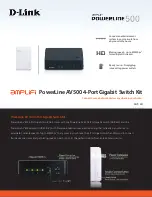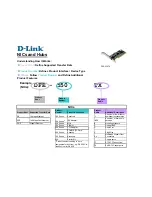
C
HAPTER
8
| Spanning Tree Algorithm
Configuring Loopback Detection
– 196 –
C
ONFIGURING
L
OOPBACK
D
ETECTION
Use the Spanning Tree > Loopback Detection page to configure loopback
detection on an interface. When loopback detection is enabled and a port
or trunk receives it’s own BPDU, the detection agent drops the loopback
BPDU, sends an SNMP trap, and places the interface in discarding mode.
This loopback state can be released manually or automatically. If the
interface is configured for automatic loopback release, then the port will
only be returned to the forwarding state if one of the following conditions is
satisfied:
◆
The interface receives any other BPDU except for it’s own, or;
◆
The interfaces’s link status changes to link down and then link up again,
or;
◆
The interface ceases to receive it’s own BPDUs in a forward delay
interval.
N
OTE
:
If loopback detection is not enabled and an interface receives it's
own BPDU, then the interface will drop the loopback BPDU according to
IEEE Standard 802.1w-2001 9.3.4 (Note 1).
N
OTE
:
Loopback detection will not be active if Spanning Tree is disabled on
the switch.
N
OTE
:
When configured for manual release mode, then a link down/up
event will not release the port from the discarding state.
CLI R
EFERENCES
◆
"Editing VLAN Groups" on page 786
P
ARAMETERS
These parameters are displayed:
◆
Interface
– Displays a list of ports or trunks.
◆
Status
– Enables loopback detection on this interface.
(Default: Enabled)
◆
Trap
– Enables SNMP trap notification for loopback events on this
interface. (Default: Disabled)
◆
Release Mode
– Configures the interface for automatic or manual
loopback release. (Default: Auto)
◆
Release
– Allows an interface to be manually released from discard
mode. This is only available if the interface is configured for manual
release mode.
Summary of Contents for ES3510MA
Page 1: ...Management Guide www edge core com 8 Port Layer 2 Fast Ethernet Switch...
Page 4: ...ABOUT THIS GUIDE 4...
Page 30: ...CONTENTS 30...
Page 40: ...FIGURES 40...
Page 46: ...TABLES 46...
Page 48: ...SECTION I Getting Started 48...
Page 72: ...SECTION II Web Configuration 72...
Page 88: ...CHAPTER 3 Using the Web Interface Navigating the Web Browser Interface 88...
Page 116: ...CHAPTER 4 Basic Management Tasks Resetting the System 116...
Page 154: ...CHAPTER 5 Interface Configuration VLAN Trunking 154...
Page 216: ...CHAPTER 8 Spanning Tree Algorithm Configuring Interface Settings for MSTP 216...
Page 350: ...CHAPTER 14 Security Measures DHCP Snooping 350...
Page 440: ...CHAPTER 17 IP Services Displaying the DNS Cache 440...
Page 484: ...CHAPTER 19 Using the Command Line Interface CLI Command Groups 484...
Page 554: ...CHAPTER 21 System Management Commands Switch Clustering 554...
Page 574: ...CHAPTER 22 SNMP Commands 574...
Page 582: ...CHAPTER 23 Remote Monitoring Commands 582...
Page 636: ...CHAPTER 24 Authentication Commands Management IP Filter 636...
Page 736: ...CHAPTER 29 Port Mirroring Commands RSPAN Mirroring Commands 736...
Page 816: ...CHAPTER 34 VLAN Commands Configuring Voice VLANs 816...
Page 830: ...CHAPTER 35 Class of Service Commands Priority Commands Layer 3 and 4 830...
Page 848: ...CHAPTER 36 Quality of Service Commands 848...
Page 900: ...CHAPTER 38 LLDP Commands 900...
Page 910: ...CHAPTER 39 Domain Name Service Commands 910...
Page 916: ...CHAPTER 40 DHCP Commands DHCP Client 916...
Page 948: ...CHAPTER 41 IP Interface Commands IPv6 Interface 948...
Page 950: ...SECTION IV Appendices 950...
Page 982: ...INDEX 982...
Page 983: ......
















































